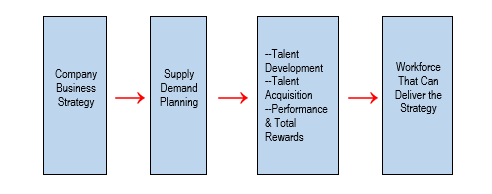“Supply chain management.” It doesn’t sound like HR, but it is the language of management, say experts Jack Tootson and Lucia Erwin.
 |
It’s important to use this language with management because it’s the wording that management uses to talk about the products they produce. Tootson, CEO at Global Performance Management Systems Inc., and Erwin, CEO of Talent Strategyzer, Inc., offered their tips during a recent BLR® webcast.
What Is Supply Chain Management?
Supply Chain Management is focused on all elements of the business. It involves several basic considerations:
- Assessing the customer DEMAND of your product and/or services. What talent do we need to achieve our business strategies?
- Ensuring that you have enough SUPPLY to fulfill the demand. What talent do we currently have employed (plus projected attrition, retirements, hires, etc.)
- GAP: What is the delta?
Demand
Demand focuses on the revenue projections, customer demand, market considerations, competitive trends, etc.
Key questions for assessing demand:
- What do we plan on selling this year?
- What is the market opportunity? Is it growing? Is demand increasing or flat?
- Do we have new products that are entering the market while others are leaving the market?
- What are our competitors doing? Who’s trying to take the customer base away from me?
Join us on Tuesday, July 28 for a free interactive webcast from LinkedIn Talent Solutions: Top Legal Pitfalls Hiring Managers Make Along the Employment Lifecycle. Learn More.
Supply
Supply focuses on materials and/or manufacturing process for product and the talent and/or people for a services business.
Key questions:
- Are the materials that we need available?
- Do we have the ability to manufacture the products?
- Do we have the talent needed to build the product?
- Do we have the talent needed to provide services to our customers?
- Is the talent in short supply?
Business leaders want a holistic view of talent, says Tootson. They don’t want separate metrics, for example, metrics concerning performance appraisals. They ask:
- Will what you are doing or what you want help me to meet my objectives?
- Can you bring me a consolidated view using metrics?
Supply and Demand Meet Talent Management
What’s the difference between Talent Management and Supply and Demand?
Talent Management. Facilitating the development and career progress of highly talented and skilled individuals in the organization using formalized procedures, resources, and processes. Talent management focuses on developing employees and leaders to meet future needs.
Supply and Demand Planning. Facilitating the planning process to identify the roles needed in order to meet the business objectives and financial forecasts to move the company forward.Supply and demand planning focuses on talent acquisitions, talent management, and workforce balancing to meet future needs. Looks at roles not individuals.
Integrating Supply and Demand in HR
HR runs a lot of programs—how much investment do I make—what does workforce need to look like—am I running the right program?
Example—One client was required to cut costs by 20% sustained for 5 years, even with growth. HR had to ask, How can we do work differently? They had to change what was going on outside and what they were doing inside. They ended up bringing more jobs in-house; also ran a university hiring program because of that. So there was a lot of emphasis on talent acquisition team, lots of university recruiting, and lots of relationship building.
And don’t forget, says Tootson, when you increase the workforce inside the building, that has implications for IT and real estate. Here’s how Tootson and Erwin picture the process:

Without the right information, it’s easy to get sued. Luckily, our free interactive webcast will keep you armed with the latest information: Top Legal Pitfalls Hiring Managers Make along the Employment Lifecycle. Earn 1 hour in HRCI Recertification Credit and 1hour in SHRM Professional Development Credit. Register Now.
Workforce of 2020
We need to engage in discussion about the workforce of 2020, says Tootson. A few factors to consider:
- The workforce will be 50% millennial.
- There will be more globalization.
- Many candidates will come from community colleges.
- Organizations will have a fear of letting poor workers go because they can’t find better qualified people to replace them.
- There will be a lot of discussion about skills and short supply.
Here are factors to consider, says Tootson:

In tomorrow’s Advisor, more from Tootson and Erwin, plus an introduction to a free interactive webcast sponosored by LinkedIn, Top Legal Pitfalls Hiring Managers Make along the Employment Lifecycle.
